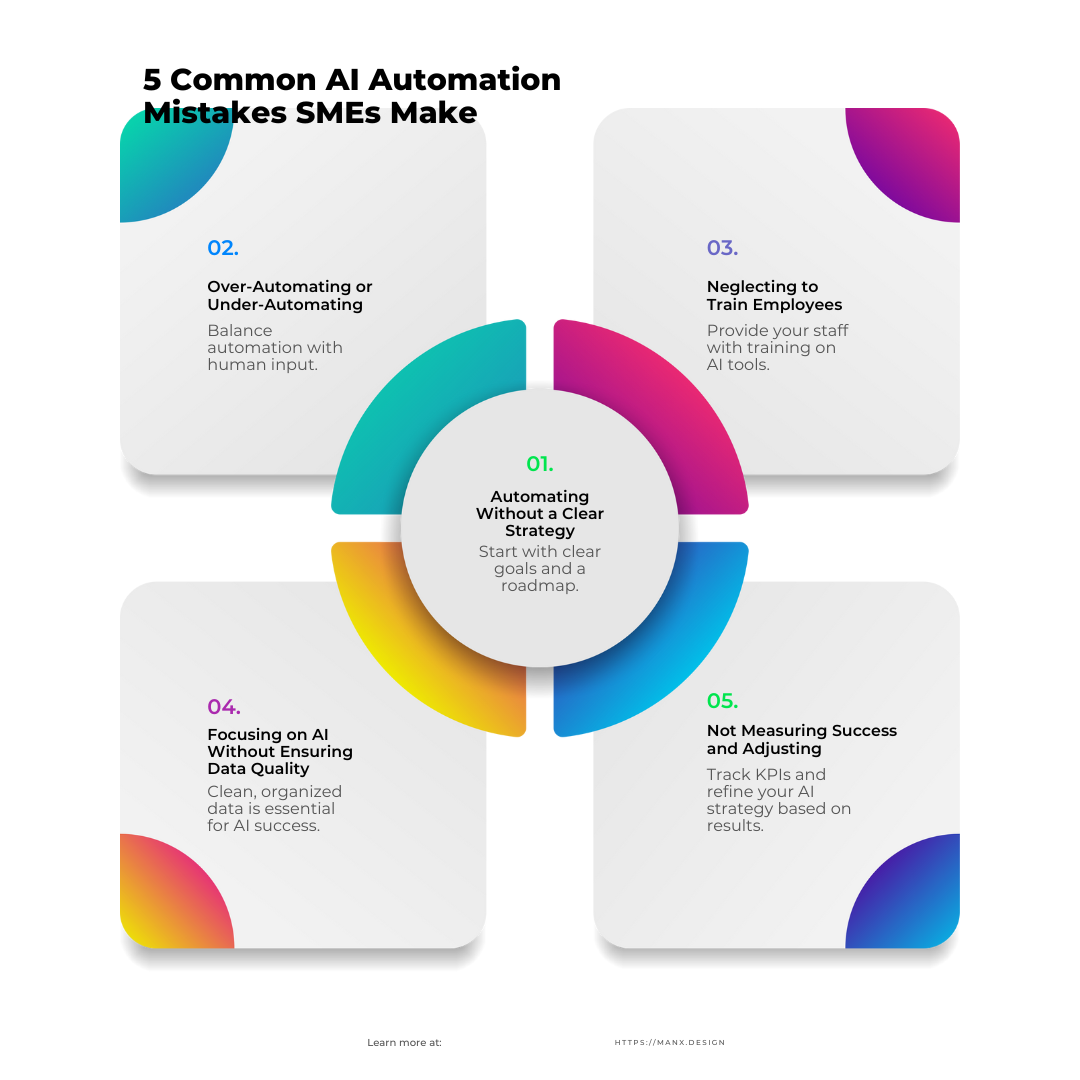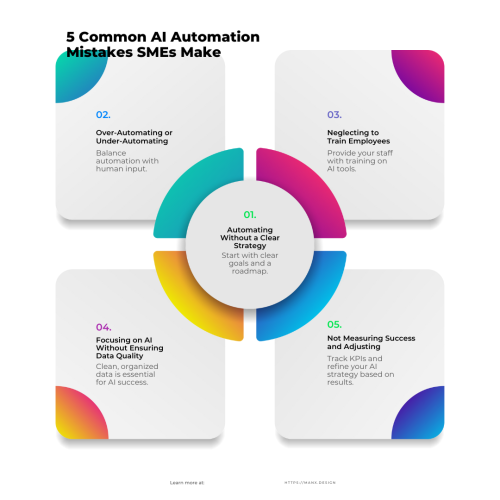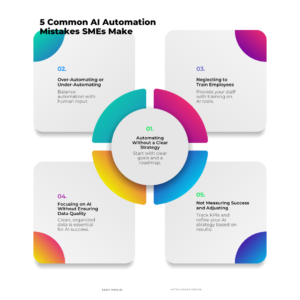
5 Common Mistakes SMEs Make When Automating Business Processes with AI
For small and medium-sized enterprises (SMEs), automation and AI represent powerful tools to streamline operations, save time, and increase productivity. However, while the potential benefits of AI are vast, many small businesses struggle to implement these technologies effectively. Poor execution can lead to inefficiencies, wasted resources, and even reduced customer satisfaction.
In this post, we’ll explore five common mistakes SMEs make when automating business processes with AI—and more importantly, how to avoid them.
1. Automating Without a Clear Strategy
One of the biggest mistakes small businesses make when adopting AI is jumping in without a clear plan. While AI can automate a wide range of tasks, it’s crucial to first understand what you want to automate and why. Without a clear strategy, you risk automating processes that don’t actually need it, or worse, misapplying AI in ways that negatively affect your business.
How to avoid this mistake:
- Start by identifying the tasks that consume the most time or resources.
- Set specific goals for what you want AI to achieve, whether it’s reducing response times, cutting operational costs, or improving decision-making.
- Develop a roadmap that outlines which processes to automate first, and then expand as you see results.
Example: Instead of automating your entire customer service system at once, start with automating common, repetitive queries, and assess how it impacts your response time and customer satisfaction.
2. Over-Automating or Under-Automating Processes
When implementing AI, it’s essential to strike the right balance between automation and human intervention. Over-automation can lead to impersonal customer experiences, errors in critical areas, or a loss of the “human touch” that is often crucial for SMEs. On the other hand, under-automating can leave you with inefficient processes that AI could easily handle.
How to avoid this mistake:
- Over-automation: Identify areas where customers or employees might still require human interaction (e.g., complex customer service inquiries or decision-making in creative tasks).
- Under-automation: Don’t be afraid to let AI handle routine, repetitive tasks such as data entry, scheduling, or responding to FAQs. The key is knowing which tasks require human intuition and which can be managed by AI.
Example: Use ChatGPT to handle simple customer inquiries like “What are your business hours?” but ensure that more complex issues—like resolving complaints—are escalated to a human agent.
3. Neglecting to Train Employees
AI tools are only as effective as the people using them. One common pitfall SMEs face is failing to properly train their staff to work alongside new AI technologies. Without adequate training, employees may not understand how to leverage these tools effectively or may even resist adopting them due to fear of job loss or confusion.
How to avoid this mistake:
- Provide thorough training for employees on how to use AI tools and how those tools integrate with existing systems.
- Communicate the benefits of automation clearly—emphasize that AI will make their jobs easier, not replace them.
- Encourage a culture of adaptability, where learning new technologies is seen as an opportunity for growth rather than a challenge.
Example: When introducing an AI-powered CRM like HubSpot, ensure that your sales team is trained not only on how to use the system, but also on how AI-generated insights can improve customer interactions and lead conversions.
4. Focusing on AI Without Ensuring Data Quality
AI’s effectiveness is largely dependent on the quality of the data it uses. If your data is incomplete, inaccurate, or poorly organized, the insights and outcomes generated by your AI systems will be unreliable. Many SMEs overlook the importance of data quality, which can lead to inefficient or even damaging automation outcomes.
How to avoid this mistake:
- Before implementing AI, ensure your data is clean, organized, and up-to-date. This might include standardizing customer information, removing duplicate entries, or validating data sources.
- Use data analytics tools to regularly audit your data quality, and invest in improving data management practices.
- Remember, AI doesn’t “fix” bad data; it amplifies whatever data it’s given.
Example: If you’re using AI to analyze customer purchasing behavior, but your customer records contain outdated or incomplete information, your AI tool might make incorrect predictions or suggest ineffective marketing strategies.
5. Not Measuring Success and Adjusting Accordingly
Another mistake SMEs often make is implementing AI solutions and assuming they’ll automatically yield results. However, like any other business investment, AI needs to be monitored, evaluated, and adjusted over time to ensure it’s delivering the desired outcomes. Without measuring success, you won’t know whether your AI tools are actually improving efficiency or if adjustments are needed.
How to avoid this mistake:
- Establish clear KPIs (Key Performance Indicators) for each AI tool or process you automate. These could include metrics like time saved, customer satisfaction rates, or error reduction.
- Regularly review these metrics to see if the AI is meeting your goals.
- Be open to refining or expanding your AI strategy based on these results. If one approach isn’t working, pivot and try something new.
Example: If you implement AI to streamline customer service and your satisfaction ratings don’t improve, evaluate whether the automated responses are meeting customer needs or if more customization is required.
Key Takeaways
Automating business processes with AI can deliver huge benefits for SMEs, but it’s not without its challenges. By avoiding these common mistakes—like jumping in without a strategy, over-automating, neglecting employee training, using poor data, and failing to measure success—your small business can harness AI to improve efficiency and grow effectively.
The key is to start small, keep refining, and always maintain a balance between technology and the human touch.
Conclusion
AI offers incredible potential for SMEs to automate repetitive tasks, enhance customer experiences, and streamline operations. However, the key to successful implementation lies in thoughtful planning, balancing automation with human input, and continually measuring performance. By avoiding these common automation mistakes, you can make the most of AI and unlock significant value for your business.

